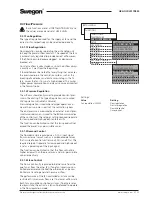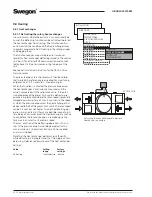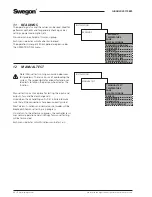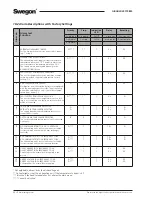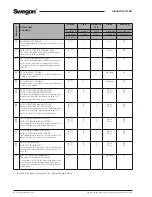
GB.GOLDLP.170830
www.swegon.com 33
We reserve the right to alter specifications without notice.
See preceding page for possibilities of setting.
9.7.3 Periodic Operation
Can be selected to run pumps if cooling relay 1 and/or 2
are used.
The exercising mode can be selected for “pump, pump +
valve” or “valve” only (0 - 10 V output). The pumps are
exercised 2 minutes per day if this is activated.
9.7.4 Regulation Speed
The required delay period between the various cooling
steps can be set.
This is done so that a compressor, for instance, will have
time generate required cooling capacity before the next
cooling step is switched in.
This applies to changeover from step 1 to step 2 and from
step 2 to step 3; and only on an increasing cooling load.
9.7.5 Outdoor Temperature Limit
Provision is available for setting an outdoor temperature-
related blocking function in 3 steps. If the outdoor tempe-
rature is below each step limit, the function of the cooling
relays will be blocked.
This function also restricts the 0-10 V output signal to
transmission in steps.
Step 1 maximises the output signal to 2.5 V, step 2 to 5.0
V and step 3 to 7.5 V.
9.7.6 Restart Time
The time should be set in such a way that it follows the
recommendations of the cooling machine supplier for the
number of starts per hour.
The restart time is calculated from the time when a relay is
energised to when it is allowed to be energised again.
The 0-10 V signal is delayed during the same period.
9.7.7 Cooling Min Air Flow
In order for the cooling function to operate the supply air
and extract air airflows must be greater than their respec-
tive limit values (preset at USER LEVEL under FLOW/PRES-
SURE).
The cooling min flow function can be blocked by setting
both flow limits to 0.
9.7.8 Neutral Zone
The neutral zone prevents the cooling and heating systems
from counteracting each other.
Preset neutral zone is added to the setpoint for heating
and the sum of these provides the setpoint for cooling.
9.7.9 Cooling BOOST
Cooling BOOST means that the supply air and extract air
airflows are increased to convey more cooling energy to
the premises.
Cooling BOOST cannot be combined with pressure regu-
lation.
The flow increase takes place between current flow and
preset max flow.
The function can be selected in five variants as follows:
Comfort
The cooling outputs are activated if there is a cooling load.
When the temperature exceeds its setpoint and the sup-
ply air temperature is within the preset limit, a regulated
ramp function begins and increases the flow. The control
reaction speed (ramp time = % flow increase/minute) can
be set. The highest possible airflow is limited by the max.
flow. For particulars on setting the max. flow, see Section
7.2.
Economy
Cooling BOOST Economy first uses a higher airflow to cool
the premises, before a start signal is transmitted to the
cooling machines.
The function can also operate without the cooling func-
tion being activated.
On a cooling load, the flows are slowly increased up to
preset maximum flow. When the flows are up to max and
if a cooing load is still present, the output contacts for
cooling are activated.
The cooling boost function requires an outdoor air tem-
perature of at least 2 °C lower than the extract air tempe-
rature for it to be activated. Normal cooling operation is
activated if the temperature difference is too small.
Sequence
The cooling BOOST Sequence is used if a cooling machine
is sized for a higher than normal cooling flow.
If there is a cooling load, the flow is increased up to the
preset max flow before the cooling function is activated.
The cooling function is delayed 1 minute after the airflow
is increased.
The cooling boost sequence is blocked if no cooling func-
tion has been selected.
C Economy
Cooling BOOST C Economy is a combination of
the two variants for increasing the airflow.
If the conditions for Cooling BOOST Economy are met, the
unit will begin increasing the airflow before the cooling
unit starts up.
If the conditions for outdoor air are not met, the flow in-
crease will begin when the supply air temperature reaches
the preset Min. permissible temperature.
E Sequence
Cooling BOOST E Sequence is a combination of
the two variants for increasing the airflow.
If the conditions for Cooling BOOST Economy are met, the
unit will begin increasing the airflow before the cooling
unit starts up.
If the conditions for outdoor air are not met, the unit will
begin increasing the airflow when the cooling unit starts
up.







